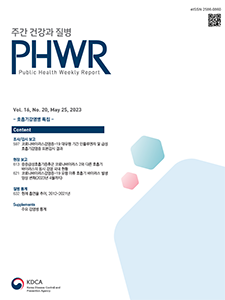Current Issue
Vol.16 No.20, May 25, 2023
-
Surveillance Reports 2023-05-25
 4
4
 484
484
 97
97
Sentinel Surveillance Results for Influenza and Acute Respiratory Infections during the Coronavirus Disease 2019 Pandemic
Jeongok Cha, Yejin Seo, Seulki Kang, Inho Kim, Jin Gwack*
Public Health Weekly Report 2023; 16(20): 597-612 https://doi.org/10.56786/PHWR.2023.16.20.1 Abstract
AbstractAs a result of sentinel surveillance for outpatients influenza-like illness ( ILI), seasonal influenza activity remains below national baseline from 13 weeks of 2020 to 8 weeks of 2023 and Inpatient surveillance results for acute respiratory infections has decreased by less than half compared to pre-coronavirus disease 2019 (COVID-19) pandemic. In the 2022–2023 season, the weekly ILI rate was above the national baseline of 4.9 per 1,000 outpatients and flu activity increased early in the 37th week of 2022. The number of hospitalized patients for parainfluenza virus infection increased rapidly from August to October 2021 and for human metapneumovirus infection have been slightly increasing after October 2022. These unusual patterns of respiratory viruses are presumed to be due to the ease of COVID-19 related social distancing and control measures.
-
Notes from the Field 2023-05-25
 0
0
 2337
2337
 248
248
Co-infection of Severe Acute Respiratory Syndrome Coronavirus 2 and Other Viral Respiratory Pathogens in the Republic of Korea
Jaehee Lee, Nam-Joo Lee, SangHee Woo, Jee Eun Rhee, Eun-Jin Kim*
Public Health Weekly Report 2023; 16(20): 613-620 https://doi.org/10.56786/PHWR.2023.16.20.2 Abstract
AbstractSevere acute respiratory syndrome coronavirus 2 (SARS-CoV-2), the virus that causes coronavirus disease 2019 (COVID-19), is co-infection with other respiratory viruses can negatively affect the patient’s clinical condition and cause difficulty in breathing, comorbidities, and increased mortality risk. Hence, the Korea Centers for Disease Control and Prevention Agency analyzed the co-infection rate of respiratory viruses, such as influenza, and the distribution by age groups in domestic COVID-19 patients. Co-infection with one or more respiratory viruses was confirmed in 104 (2.0%) of 5,171 COVID-19-positive samples collected from January to December 2022. The detection rate of co-infection with respiratory pathogens was highest at 15.8% in the age group of 0–6 years. The immature immune system of children and environmental resistance of non-enveloped viruses may have contributed to the high co-infection detection rate. As the spread of respiratory viruses is increasing due to relaxation of the COVID-19 restrictions and co-infections are expected to increase, we will continue to monitor co-infections of SARS-CoV-2 and other respiratory viruses closely.
-
Notes from the Field 2023-05-25
 1
1
 752
752
 113
113
Changes in Patterns of Respiratory Virus since the Coronavirus Disease 2019 Pandemic (Until April 2023)
Inho Kim, Seulki Kang, Jeongok Cha, Yejin Seo, Jin Gwack, Nam-Joo Lee, SangHee Woo, Jee Eun Rhee, Eun-Jin Kim
Public Health Weekly Report 2023; 16(20): 621-631 https://doi.org/10.56786/PHWR.2023.16.20.3 Abstract
AbstractThe coronavirus disease 2019 (COVID-19) pandemic has significantly impacted the trend of influenza and respiratory virus infections, leading to substantial changes in their seasonal patterns. This study aimed to describe the impact of COVID-19 on the pattern of respiratory virus infections by analyzing the trend (such as detection rate) of respiratory pathogens in patients with respiratory symptoms who visited sentinel sites and by examining the surveillance results of inpatient surveillance at general hospitals. The analysis covers a 3-year period before the COVID-19 outbreak (2017–2019) and the period following the ease of social distancing measures during the COVID-19 pandemic (2022–2023). As of 2023, respiratory viruses such as influenza virus, rhinovirus, human coronavirus, adenovirus, and human bocavirus continue to show seasonal patterns similar to those observed before the COVID-19 pandemic. However, respiratory syncytial virus, parainfluenza virus, and human metapneumovirus, have shown different seasonal patterns. During the spring of 2023, with the exception of human coronavirus, the detection rate and hospitalization of other respiratory viruses have shown an increasing trend. This emphasizes the need for continuous monitoring and information sharing regarding the overall increase and changes in respiratory viruses at the end of COVID-19 pandemic period.
-
QuickStats 2023-05-25
 4
4
 725
725
 162
162
Trends in the Prevalence of Current Cigarette Smoking, 2012-2021
Public Health Weekly Report 2023; 16(20): 632-633 https://doi.org/10.56786/PHWR.2023.16.20.4

pp. 1433~1461
Most Keyword
?
What is Most Keyword?
- It is the most frequently used keyword in articles in this journal for the past two years.
Most Read
-
Waterborne and Foodborne Disease Outbreaks in the Republic of Korea, 2023
Myung-Jae Hwang, So Yeon Park, Hyungjun Kim, Se Jeong Yang, Sungchan Yang, Jin Seon Yang
Public Health Weekly Report 2025;18: 17-32 https://doi.org/10.56786/PHWR.2025.18.1.2 -
Implementation Plan for the Coronavirus Disease 2019 Vaccination for the 2024–2025 Season: Recommendations of the 6th Expert Committee on Immunization Practices
Hyewook Hwang, Wookeon Lee, Seohyeon Ahn, Young-Sook Choi, Seunghyun Lewis Kwon, Dongwoo Lee, Eun Hwa Choi, SokGoo Lee
Public Health Weekly Report 2025;18: 90-102 https://doi.org/10.56786/PHWR.2025.18.2.3
Editorial Office
+82-43-719-7569





 Full Text
Full Text Cite
Cite


